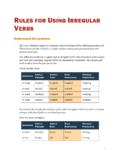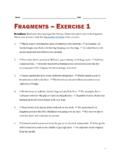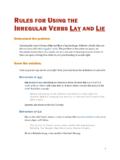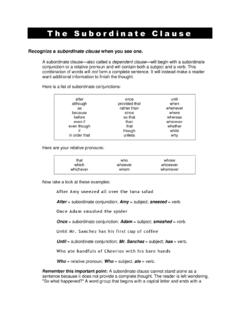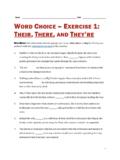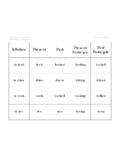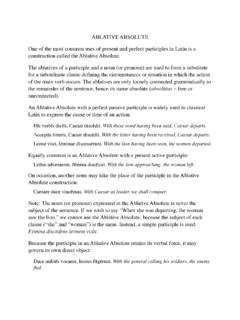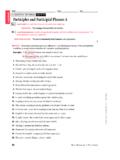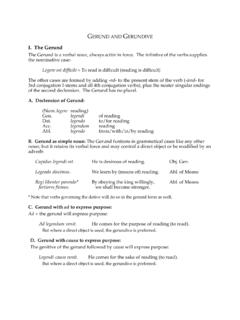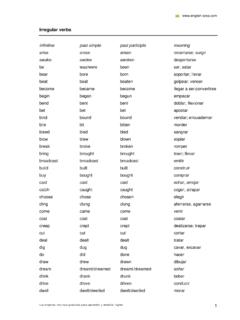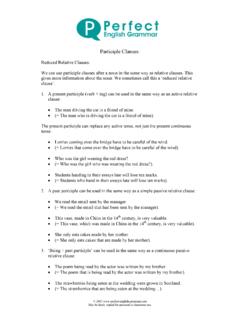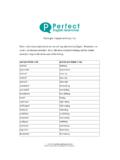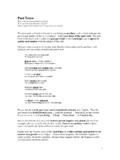Transcription of T he Par t i ci pl e
1 T h e P a r t i c i p l e Recognize a participle when you see one. participles come in two varieties: past and present. They are two of the five forms or principal parts that every verb has. Look at the charts below. R e g u l a r V e r b s : V e r b S i m p l e P r e s e n t S i m p l e P a s t P a s t P a r t i c i p l e P r e s e n t P a r t i c i p l e I n f i n i t i v e giggle giggle(s) giggled giggled giggling to giggle help help(s) helped helped helping to help jump jump(s) jumped jumped jumping to jump I r r e g u l a r V e r b s : V e r b S i m p l e P r e s e n t S i m p l e P a s t P a s t P a r t i c i p l e P r e s e n t P a r t i c i p l e I n f i n i t i v e bring bring(s) brought brought bringing to bring ring ring(s) rang rung ringing to ring sing sing(s) sang sung singing to sing swim swim(s) swam swum swimming to swim Notice that each present participle ends in ing.
2 This is the case 100 percent of the time. On the other hand, you can see that past participles do not have a consistent ending. The past participles of all regular verbs end in ed; the past participles of irregular verbs, however, vary considerably. If you look at bring and sing, for example, you'll see that their past participles brought and sung do not follow the same pattern even though both verbs have ing as the last three letters. Consult a dictionary whenever you are unsure of a verb's past participle form. Know the functions of participles . participles have three functions in sentences. They can be components of multipart verbs, or they can function as adjectives or nouns.
3 P a r t i c i p l e s i n M u l t i p a r t V e r b s A verb can have as many as four parts. When you form multipart verbs, you use a combination of auxiliary verbs and participles . Look at the examples below: Our pe t a ll iga t or at e Mrs. O lse n's po odl e. Ate = simple past tense [no participle]. Wi th a bro om, Mrs. Olse n was beating our a ll iga t or ov er the he ad i n a n a t te mp t t o re trie ve h er poo dl e. Was = auxiliary verb; beating = present participle. Our pe t a ll iga t or has been stalki ng n e igh bor ho od p et s bec au se my br o ther Bill y f orge ts t o fee d the po or rep t ile.
4 Has = auxiliary verb; been = past participle; stalking = present participle. Our pe t a ll iga t or should have been eating G a tor C ho w, c runc hy nug ge ts th a t Bi ll y le ave s for hi m in a b ow l. Should, have = auxiliary verbs; been = past participle; eating = present participle. P a r t i c i p l e s a s A d j e c t i v e s Past and present participles often function as adjectives that describe nouns. Here are some examples: The cr ying b ab y dre w a l on g bre at h a nd suc ke d i n a spi der crou chi ng in the c orner of the c r ib. Which baby? The crying baby. Which spider?
5 The one that was crouching in the corner. The mangled p air o f sun gl as ses, bruised fac e, broken arm, a nd bleeding kne es m ea nt Gen et t e ha d t ak en ano t her spi ll on h er m oun t ai n bi ke. Which pair of sunglasses? The mangled pair. Which face? The bruised one. Which arm? The broken one. Which knees? The bleeding ones. P a r t i c i p l e s a s N o u n s Present participles can function as nouns the subjects, direct objects, indirect objects, objects of prepositions, and subject complements in sentences. Whenever a present participle functions as a noun, you call it a gerund.
6 Take a look at these examples: Sneezing ex hau s ts Ste ve, who r eq uire s eig ht ti ss ues an d tw en ty-sev en G esu n dhe it s be for e he is d one. Sneezing = the subject of the verb exhausts. Valer ie ha tes cooki ng bec a us e sc rap in g burn t g oo k o ut of pan s a lw ay s un der mi nes her e njo yme nt o f th e fo od. Cooking = the direct object of the verb hates. We g ave bung ee ju mping a c h anc e. Bungee jumping = indirect object of the verb gave. Joel le b it her to ng u e in st ea d of criti ci zing h er pr om d a te' s pow der blu e t uxe do. Criticizing = object of the preposition instead of.
7 Omar's le as t fa vor it e sp ort is water-ski ing b ec au se a ba d spi ll onc e c a use d h i m t o lo se hi s sw im t runk s. Water-skiing = the subject complement of the verb is. 1997 - 2014 by Robin L. Simmons All Rights Reserved.
